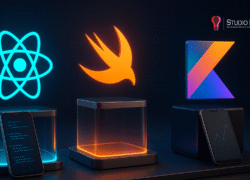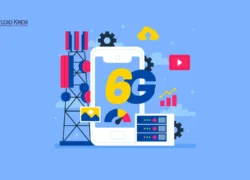In less than three decades, mobile gaming has skyrocketed from a novelty to a global juggernaut, captivating millions across the globe. With the mobile gaming market expected to surge past 164.81 billion U.S. dollars by 2029, driven by a 10.39% CAGR, the allure of mobile gaming continues to intensify as smartphone usage reaches unprecedented heights. Mobile gaming reigns supreme today, commanding over half of the total video game revenue worldwide. Understanding the Mobile Game Development Cost is paramount in navigating this thriving industry, making finding the right Mobile Game Development Company essential for turning gaming visions into reality.
* Source: https://www.mordorintelligence.com/industry-reports/mobile-games-market
You’re excited and ready to dive in, but there’s one thing looming over your head: The Cost. How much is this going to set you back? In general, the cost of Mobile Game Development can start at a ballpark figure of $3,000 in USD and range up to a million dollars. But this wide range is unlikely what you are expected to be the answer to your question and look into the more reasonable and detailed response to your question. Fear not because we’re here to break it down for you. Let’s talk about the factors that influence the price of mobile game development and how you can get a precise estimate.
This blog post will discuss the essential factors that influence the cost of creating your dream mobile game. Understanding what influences mobile game development prices and how to estimate costs accurately can save you from surprises down the road. Let’s dive in!
Why use Mobile Games over other devices?
Mobile games are an excellent choice for developers because of their accessibility and reach. With billions of smartphone users worldwide, the potential audience for your Game is vast. The evolving technology of mobile devices also allows for increasingly sophisticated gaming experiences, making them an attractive platform for developers.
Smartphones offer a convenient and accessible gaming platform. With improved hardware capabilities and advanced graphics, smartphones can provide a rich gaming experience. This accessibility makes mobile gaming appealing to a broader audience, including casual gamers who may not invest in dedicated gaming consoles or P.C.s.
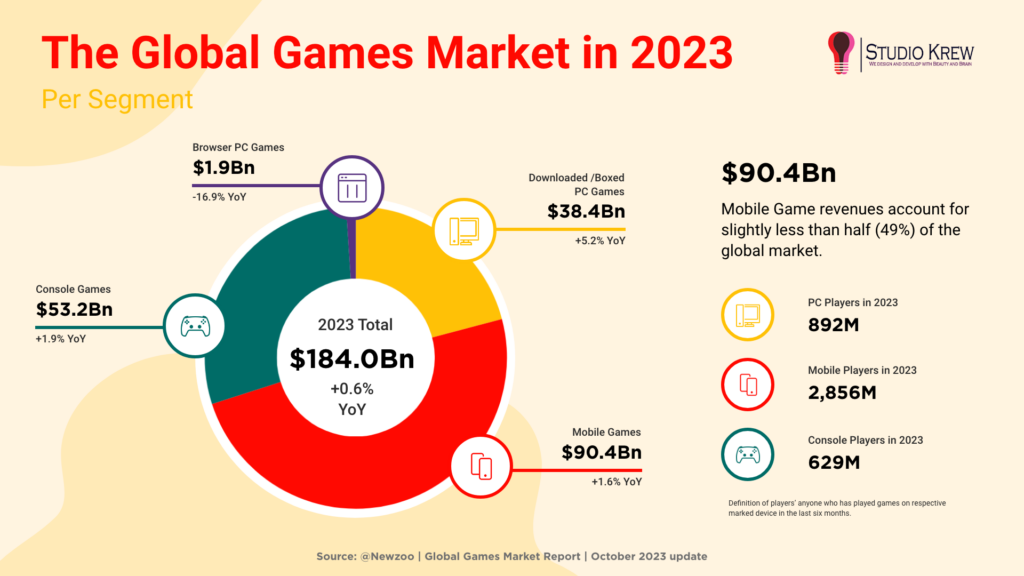
According to Cisco, the global number of mobile subscribers (those who use cellular services) is expected to rise from 5.1 billion in 2018 to 5.7 billion by the end of 2023, at a CAGR of 2 per cent. Mobile subscribers accounted for 66 per cent of the global population in 2018 and 71 per cent of worldwide population penetration by 2023. As smartphone ownership continues to rise globally, the demand for mobile games is expected to increase, creating new opportunities for game developers, publishers, and other stakeholders in the industry.
Mobile Gaming Statistics & Facts
Mobile games are gaining traction. There are billions of mobile game downloads from app stores and play stores, signifying its market’s presence and potential market growth. Let’s dive into the details of these remarkable trends and what they mean for the mobile gaming landscape.
Fact 1: 90 billion mobile game downloads across both app stores in 2022. (Udonis)
Despite revenue declines, mobile game downloads surged 17.4%. In 2022, they reached almost 90 billion, 6 billion more than in 2021. Hyper-casual games were the main driver of downloads.
Fact 2. By 2025, the mobile games industry will reach $138 billion. (Sensor Tower)
The figure above includes mobile gaming industry statistics for Apple Store and Google Play. Mobile gaming adoption has accelerated significantly since the first smartphones. At one point, there was “Angry Birds.” Then, Pokemon G.O. and Fortnite took over the world.
Fact 3. In the U.S., people usually have around eight games installed per device. (TechCrunch)
On a global level, people play two to five games monthly. The hours these users spend on games grow at 10% per year. In 2019, mobile gaming accounted for 10% of all user spending on apps. Mobile and video game usage statistics show that mobile games were on track to account for 60% of consumer spending by the end of 2019.
Fact 4. In 2020, players spent 4.2 hours daily on Android mobile games. (App Annie)
This number of hours translates to 3.5 trillion, up 20% from 2019. For comparison, people spent 3.7 hours watching T.V. simultaneously.
Despite the stereotype that only young people spend time on mobile games, it’s not quite like that. For instance, in the US, Gen X or Baby Boomers spend 30% more time on their most-used apps. In addition, core games account for 55% of the time spent on games.
Fact 5. Subway Surfers is The most popular Android game app in the U.S. (Statista)

Subway Surfers has nearly two million active users daily, making it one of the most “populous” games. It is followed by:
- Clash of Clans: 1.94 million daily active users
- Candy Crush Saga: 1.4 million active daily users
- 8 Ball Pool: 1.45 million active daily users
- Roblox: 1.14 million active daily users
Phases in Creation of Mobile Game.
How much does it cost to develop a game app? Launching a mobile game is a complex process involving different phases, each with its unique requirements and costs. To better understand the process and the expenses involved, it’s essential to break down the entire process into smaller, more manageable parts. Let’s dive into each phase to understand its role in creating a mobile game and learn how and where your money will be invested.
Delving into Market Research
Before diving into development, taking your time to understand your audience, analyze competitors, and stay updated with market trends is recommended. This phase lays the foundation for shaping your game concept and strategy, ensuring it resonates with your target audience.
Crafting Your Game Design Document
Think of this phase as creating the blueprint for your Game. Here, you’ll outline the core concept, including art style and genre, mechanics, and features that will define your Game’s identity and gameplay experience. The game producer or lead designer prepares this document, which serves as a guiding document for the development process.
Defining Technical Specifications
Determining the technical specifications and architecture is essential to bringing your Game to life. This step provides your development team with a clear roadmap, ensuring a smooth and efficient development process. This phase includes planning Game Mechanics, Game Physics, Game Object Data, Game Engine, Backend Services, etc. This helps you estimate the cost of the work and time estimations. The technical Director or Lead Programmer prepared these.
Prototyping for Perfection
Creating early versions of your Game allows you to test gameplay mechanics and ideas, refining your Game’s design and functionality. It’s vital to identify and address any potential issues before moving forward.
Crafting Compelling Game Design
In this phase, focus on developing visuals, characters, and environments to captivate and immerse players in your game world. Creating a captivating and engaging experience is vital in keeping players returning for more.
Bringing Your Vision to Life with Game Programming
This is where the real magic happens. Code the game mechanics, user interface elements, and functionality to make your Game interactive and enjoyable for players.
Setting the Mood with Sound Design
Music, sound effects, and voiceovers add depth and immersion to your Game. Thoughtful sound design enhances the overall experience, enriching your Game’s atmosphere and engaging players on a deeper level.
Ensuring Quality through Testing and Quality Assurance
Identifying and fixing bugs or issues is essential to ensure your Game runs smoothly across different devices and platforms. Rigorous quality assurance is key to delivering a polished final product that meets player expectations.
Launching and Maintaining
Once your Game is ready, it’s time to launch it into the world. Monitor its performance closely and provide ongoing updates and support to keep players engaged and satisfied. Continuous improvement is key to long-term success.
By understanding each phase of the mobile game development process, you gain insight into the work involved and the costs associated with each stage. This understanding will help you plan and budget your game development project more effectively. Now, let’s delve into the factors that influence the price of mobile game development in more detail.
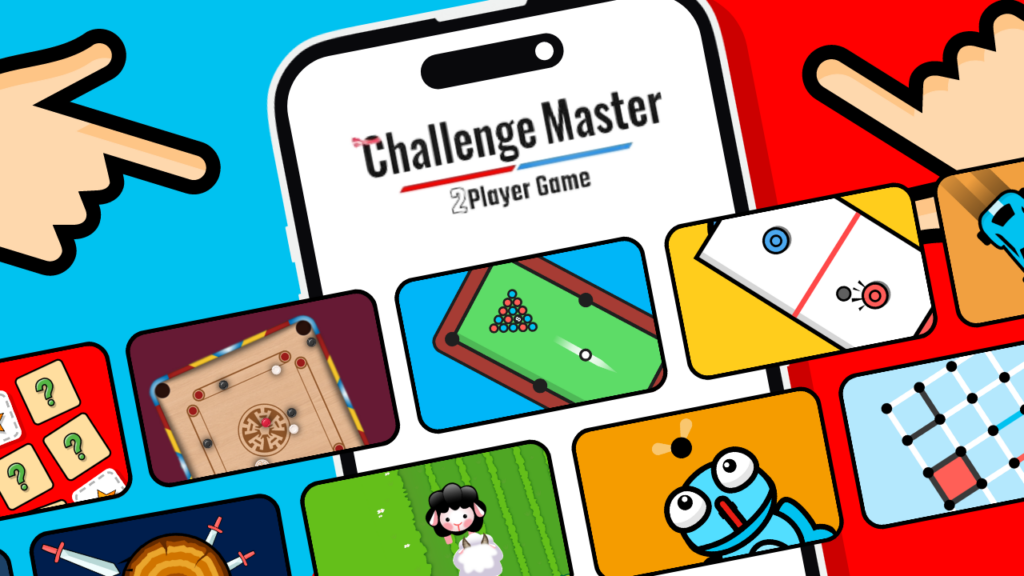
Understanding the Factors: What Affects Mobile Game Development Cost?
As you embark on your journey to develop a mobile game, it’s essential to understand the variables that influence its cost. Let’s dive into the details:
Platforms:
Consider whether you’re developing for iOS, Android, or both. Each platform has its own set of requirements and nuances, impacting development time and cost. Game engines are available that provide Cross-platform games supporting both Android and iOS. However, certain device-centric optimizations are required for both platforms individually.
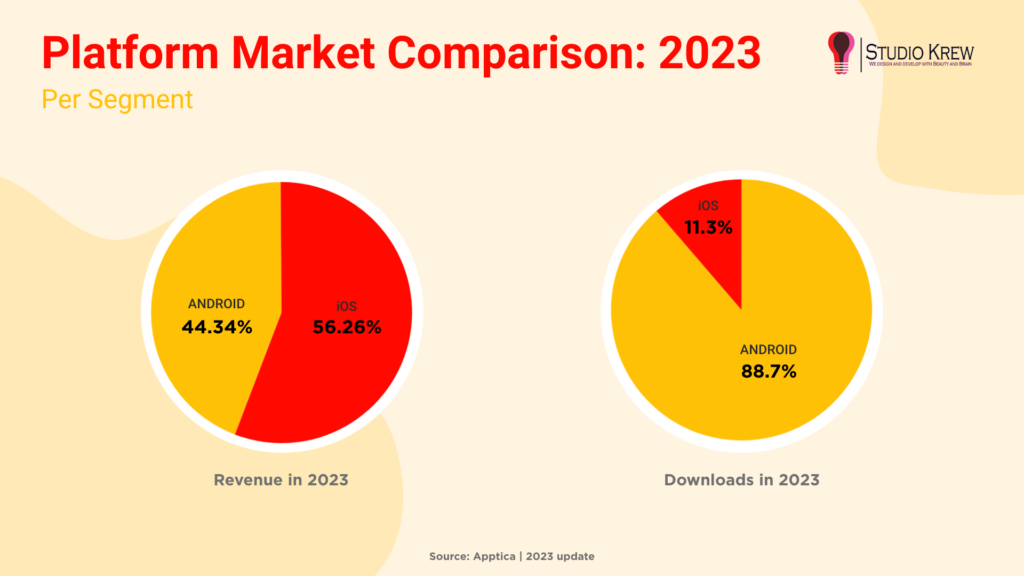
The App Store produced over half of the mobile gaming revenue in 2023. Meanwhile, Android covered the rest, at 43.74%. While iOS had the highest income, Google Play obtained the most downloads in the first half of 2023.
88.63% of the total mobile game downloads were made with Android. This high rate is directly attributed to how most mobile games are developed for Android.
Even though iOS earns more revenue from mobile games, Android gains a more significant portion of its overall revenue from mobile games. Games account for 61% of revenue generation on iOS and 77% on Android.
The complexity of the Game:
The complexity of your Game can be broken down into several factors:
- Technical Complexity: Intricate features and mechanics require more development time and resources.
- Unique Selling Point: Innovative gameplay mechanics or groundbreaking features may require additional investment.
- Server Load: Due to infrastructure requirements, Multiplayer games or those with heavy server usage can incur higher costs.
- Game Playtype: Whether your Game is multiplayer or single-player can significantly affect development costs, as multiplayer games often require more robust backend systems.
Graphics, Design, and Art Style:
High-quality visuals can enhance player experience but come at a cost. Consider the level of detail and sophistication required for your Game’s graphics and art style. Let’s delve into the intricate world of graphics, design, and art style and explore how these elements influence the cost estimations of your mobile game project.
Visual Complexity: Balancing Intricacy and Efficiency
The complexity of your Game’s visuals plays a significant role in determining development costs. Each aesthetic choice, from minimalist designs to intricate, high-fidelity graphics, carries its production requirements and associated expenses. Delving into detailed textures, intricate animations, and elaborate environments can drive up costs due to the additional time and resources required for implementation.
Artistic Direction: Setting the Tone
Choosing the right art style sets the tone and atmosphere for your Game, shaping the player’s experience. Whether opting for vibrant, cartoonish visuals or realistic, immersive environments, the chosen art style directly impacts development costs. More elaborate styles often necessitate extensive design work and meticulous attention to detail, potentially increasing production expenses.
Customization and Personalization: Enhancing Player Engagement
In mobile gaming, customization options and personalized experiences are key factors that can enhance player engagement and retention. However, incorporating such features often requires bespoke artwork and design elements, which can contribute to higher development costs. Therefore, investing in tailored visuals and interactive elements can elevate the player experience, but it’s essential to carefully budget and manage expenses effectively.
It’s important to note that your mobile Game’s graphics, design, and art style are integral components that significantly impact development costs. By considering the intricacies of visual development and collaborating with talented professionals, you can create a visually stunning masterpiece that captivates players and sets your Game apart in a competitive market. So, it’s crucial to balance investing in bespoke artwork and design elements and managing expenses effectively to make your Game stand out and succeed.
Type and Functionality:
When delving into the realm of mobile game development, the type and functionality of your Gameplay play a pivotal role in shaping both the player experience and the associated development costs. Let’s explore the nuances of game types and functionality and how they influence the estimation of costs:
Single Player vs. Multiplayer Dynamics: Defining Player Interaction
The choice between single-player and multiplayer dynamics significantly impacts development costs. Single-player games typically involve more straightforward gameplay mechanics and require less infrastructure for player interaction, resulting in lower development costs. Conversely, multiplayer games necessitate complex networking systems, server architecture, and synchronization mechanisms, driving up development expenses.
This also refers to a new type of game called Massive Multiplayer Online games, also known as MMO games. Unlike PVP games, in these games, a large pool of users interact with each other. These games can be immersive or semi-immersive and can be developed for mobile devices, PCs, or Web3 platforms. The most common example of such games is the Metaverse Gaming platform or Immersive VR Mobile Game Application platforms.
Game Type
- 2D Mini Game: Simple gameplay mechanics and basic features typically lower development costs.
- Casual 2D Game: More complex mechanics and additional features may increase development time and cost.
- Mid-Level 3D Game: Incorporating 3D elements adds complexity and cost compared to 2D games.
- Hardcore 3D Game: Complex gameplay mechanics, advanced features, and high-quality graphics increase development costs.
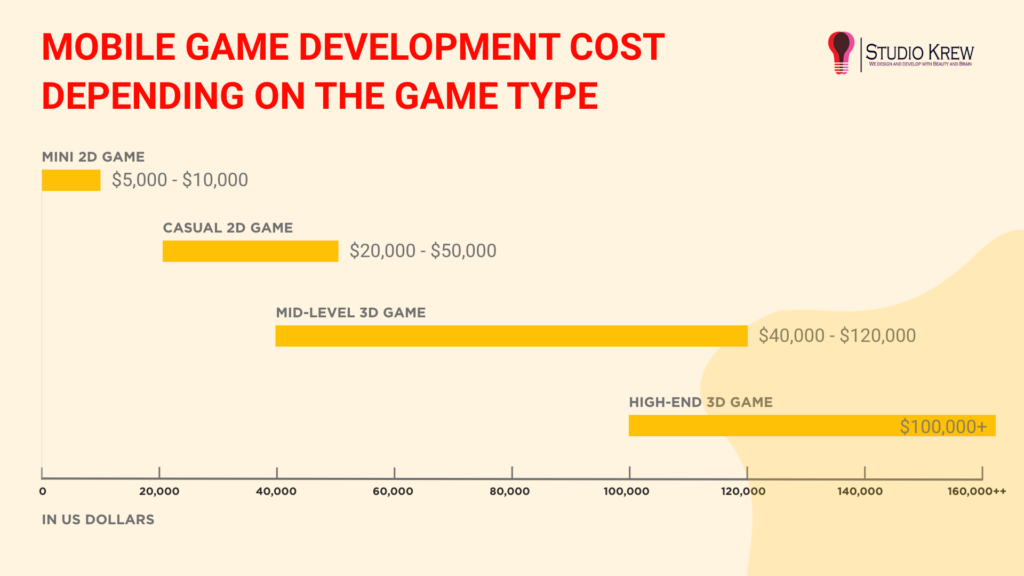
Replay Value and Longevity: Sustaining Player Engagement
Games with high replay value and longevity often require additional development efforts and resources. Implementing features such as procedurally generated content, dynamic difficulty scaling, or ongoing content updates can enhance player engagement and extend your Game’s lifespan. However, these features necessitate continuous development and support, increasing long-term costs.
The type and functionality of your mobile Game are fundamental factors that significantly influence development costs. By carefully considering the complexities of gameplay dynamics and prioritizing features that enhance player engagement and enjoyment, you can create a compelling gaming experience while effectively managing development expenses.
Expertise and Experience of Production Team:
When it comes to mobile game development, the expertise and experience of your production team can significantly impact the quality of the final product and the efficiency of the development process. While its more experienced teams may have a higher price tag, their ability to deliver superior results in less time often justifies the investment.
The level of expertise of your development team directly influences the quality of the artwork, technical aspects, and overall work speed. Seasoned professionals bring a depth of knowledge and skill to the table, allowing them to tackle challenges with confidence and finesse.
While it’s difficult to pinpoint the exact correlation between experience and cost, hiring an experienced team may, on average, result in a price 1.5 times higher than that of a newly formed company. However, the value that comes with this investment is undeniable.
At StudioKrew, we pride ourselves on our extensive experience in game development services. With more than 50 projects across various genres and difficulty levels, we have the expertise and know-how to bring your vision to life. Our portfolio speaks for itself, showcasing our commitment to delivering top-quality games that captivate and engage players. When you partner with StudioKrew, you’re not just getting a development team but a trusted partner dedicated to your success.
Testing and Quality Assurance:
Testing and Quality Assurance (Q.A.) are crucial in the mobile game development lifecycle, ensuring that the final product meets user expectations and industry standards. Q.A. engineers meticulously examine various aspects of the gaming application, including its appeal to users, feature set, design usability, accessibility, and media quality. Their goal is to deliver an error-free product that delights users and aligns with project requirements.
It’s essential to recognize the distinct role of testers in the development process. While some may believe that testing falls within the purview of project managers, developers, or clients, this misconception can lead to costly errors. Neglecting thorough testing can result in a game that fails to run on specific devices, contains critical gameplay bugs, or suffers from unverified monetization strategies – ultimately undermining the project’s success.
Quality assessment services are typically integrated into the overall cost of game development, and for good reason. Attempting to cut corners by skimping testing expenses can have dire consequences, potentially negating all prior efforts invested in the project. The consequences of releasing a buggy or incomplete Game can be detrimental, tarnishing the Game’s reputation and impeding its success in the competitive mobile gaming market.
By prioritizing rigorous testing and Q.A. throughout the development process, you can mitigate risks, enhance user satisfaction, and maximize the chances of your Game’s success. Embrace testing as an indispensable component of the development journey, ensuring that your Game meets and exceeds user expectations.
Marketing and Liveops:
When it comes to mobile game development, marketing and live operations (Liveops) are often overlooked aspects that can significantly impact the success of your Game. Without effective marketing, your Game may get lost in the sea of new releases, regardless of its quality or innovation. Therefore, it’s essential to incorporate a robust marketing strategy into your development plan from the outset.
There are two primary approaches to handling marketing for your Game. First, you can choose to manage marketing efforts in-house with your team. This option provides you with direct control over your marketing strategy and execution, but it also requires expertise and resources to reach your target audience effectively.
Alternatively, you can outsource marketing activities to a specialized agency or collaborate with your development partner. This approach offers the advantage of leveraging the expertise and experience of professionals specialising in mobile game marketing. These teams typically provide services, including App Store Optimization (ASO), Search Engine Optimization (SEO), advertising campaigns, and comprehensive marketing strategies tailored to your Game’s needs.
Entrusting marketing responsibilities to a dedicated team can benefit you from their holistic approach to promotion. They will ensure that your Game receives maximum visibility and engagement across various channels. This includes leveraging social media platforms, influencer partnerships, and press releases to generate buzz and anticipation for your Game even before its release.
It’s important to note that the cost of marketing services is typically not included in the initial development budget. However, by collaborating closely with your development partner and incorporating marketing expenses into your overall project budget, you can ensure a cohesive approach to development and promotion. This alignment allows you to avoid underestimating marketing costs and ensures that your Game receives the attention it deserves in the competitive mobile gaming market.

Also Read: All About Games LiveOps: Should You Do It? Read Now
In addition to marketing, Liveops play a crucial role in a mobile game’s ongoing success and sustainability. Liveops encompass a variety of ongoing operational activities that ensure the smooth functioning of the game post-launch, as well as the continued engagement of players. Here’s a deeper look into some key components of Liveops:
- Server Costs: One of the essential aspects of LiveOps is maintaining the Game’s server infrastructure. This includes covering the costs of hosting and maintaining servers to support Gameplay, store player data, and facilitate online interactions. Server fees are typically recurring expenses that must be budgeted to ensure uninterrupted service and optimal performance for players.
- Third-Party License Fees: Many mobile games rely on third-party technologies or services, such as game engines, analytics platforms, or ad networks. These services often require ongoing license fees or royalties, contributing to the Game’s overall operational costs. Budgeting for these fees is essential to maintaining access to critical tools and services that enhance the game experience and support monetization strategies.
- Seasonal Updates: Regular content updates and events are essential to keeping players engaged and interested in the Game over the long term. Seasonal updates introduce new features, levels, challenges, and rewards to keep the Gameplay fresh and exciting. Planning and implementing these updates require resources for content creation, development, testing, and coordination with marketing efforts to promote the updates effectively.
- Technical Support: Providing ongoing technical support is another critical aspect of Liveops. Players may encounter issues or have questions about the Game, and prompt and effective technical support is essential for maintaining player satisfaction and retention. This includes addressing bug reports, troubleshooting technical issues, and responding to player inquiries through various channels, such as email, forums, or social media.
Incorporating LiveOps activities into your budget planning will help your Game stay competitive and engaging in the ever-changing mobile gaming industry. By allocating resources for server fees, third-party license fees, seasonal updates, and technical support, you can ensure a seamless and enjoyable experience for your players. This will maximize the long-term success and profitability of your Game. If you want to learn more about Game LiveOps services, you can refer to the link provided. Alternatively, if you are looking for a LiveOps partner for your mobile Game, feel free to contact the StudioKrew Business team for a free estimation.
How the Mobile Game Cost Estimation Works?
Estimating the cost of developing a mobile game is akin to charting a course through uncharted waters. It demands a keen understanding of the project scope, technical intricacies, and potential pitfalls that may lie ahead. This section will delve into the intricate workings of mobile game cost estimation, shedding light on the process and factors influencing price.
Typically, the cost estimate takes place in two stages:
Initial Assessment: Setting the Foundation
The estimation process typically unfolds in two stages, starting with a preliminary cost estimate. Despite its label as “rough,” this initial assessment provides a foundational understanding of the investment required to bring your game concept to life. It offers invaluable insights before formalizing contracts, allowing you to gauge feasibility and make informed decisions.
Following the preliminary estimate, the journey progresses to a detailed pricing phase. An agreement is forged here, fixing the terms, stages, and final development cost. This agreement encompasses a comprehensive breakdown of project phases, milestones, and deliverables, fostering clarity and accountability throughout development.
Detailed Pricing: Crafting Clarity
Following the preliminary estimate, the journey progresses to a detailed pricing phase. An agreement is forged here, fixing the terms, stages, and final development cost. This agreement encompasses a comprehensive breakdown of project phases, milestones, and deliverables, fostering clarity and accountability throughout development.
As the development process progresses, the original project scope may change, which can impact the final cost of the project. Developers may need to adjust the Game’s features to align with evolving requirements or incorporate new insights. This flexibility ensures that the final product meets the client’s vision while staying within the budget constraints.
Collaborating with an experienced development team can streamline the estimation process. Their expertise in creating games with similar features and Gameplay can provide valuable insights, leading to more accurate cost assessments. A legal contract can also protect the Game’s originality and prevent any unauthorized resale, mitigating potential risks.
If you are still confused or interested in Mobile Game Development services and would like to receive a proposal, connect with the StudioKrew Business team. You can receive a free initial assessment or draft proposal in two working days. Contact them now!
In addition to production costs, it is crucial to consider the expenses associated with releasing a mobile game. Posting your application on platforms like Google Play and the App Store incurs fees, such as an annual fee of $99 for the App Store and a one-time fee of $25 for Google Play. These costs allow access to developer libraries and store distribution channels, making launching your Game to a global audience easier.

Planning your Mobile Game Budget: A Step-by-Step Guide
Congratulations on embarking on the exciting journey of mobile game development! As you dive into this creative endeavour, it’s essential to have a solid plan in place for managing your budget effectively. This guide will walk you through the critical steps of planning your mobile game development budget, ensuring you can bring your vision to life without breaking the bank.
Define Your Game Concept
Before you can dive into budget planning, you need to have a clear understanding of your game concept. Take the time to outline your Game’s vision, mechanics, and target audience. By defining these key aspects upfront, you’ll better understand the resources needed to bring your Game to fruition.
Map Out Revenue Models
Consider how you’ll monetize your Game to generate revenue. Will you rely on in-app purchases, ads, subscriptions, or premium pricing? Each revenue model comes with its own set of costs and considerations. By mapping out your revenue strategy early on, you can align your budget accordingly and ensure your monetization goals are achievable.
Budget for Marketing and Liveops
Marketing is crucial to launching a successful mobile game. Allocate resources for advertising campaigns, app store optimization (ASO), and ongoing LiveOps activities such as seasonal updates and technical support. Investing in marketing ensures your Game gets the visibility it deserves in the competitive app marketplace.
Plan for Progressive Updates
Your Game’s journey doesn’t end at launch – it’s just the beginning. Plan for regular content updates to keep players engaged and excited. Whether it’s introducing new levels, characters, or features, progressive updates are key to retaining players and driving long-term success.
Account for Recurring Expenses
Mobile game development is an ongoing process that requires ongoing maintenance and support—factor in recurring expenses such as server fees, third-party license fees, and ongoing development costs. By accounting for these expenses upfront, you can ensure the continued success of your game post-launch.
Planning your mobile game development budget is a critical step in ensuring the success of your project. By defining your game concept, mapping out revenue models, budgeting for marketing and Liveops, planning for progressive updates, and accounting for recurring expenses, you can set yourself up for success. Remember, effective budgeting isn’t just about allocating funds—it’s about making informed decisions that support your Game’s long-term success and profitability. So take the time to craft a thoughtful budget that reflects your vision and goals, and watch your mobile Game thrive in the marketplace.
At StudioKrew, we understand the intricacies of mobile game development and the importance of effective budget planning. Our team has a proven track record of delivering high-quality games within budget constraints, ensuring our clients achieve their goals without overspending. With our expertise and guidance, you can confidently navigate the mobile game development process and bring your vision to life.
Breaking Down the Umbers: Average Mobile Game Development Costs.
Understanding the intricacies of mobile game development costs is pivotal for effective budgeting and project planning. Let’s delve into a breakdown of average costs associated with creating a mobile game, offering insights into the factors influencing pricing.
Elementary 2D Games:
The average cost for simple 2D games with basic mechanics and minimal artwork typically ranges up to $10,000. These games often feature straightforward gameplay and uncomplicated graphics, making them accessible to developers on a budget or those looking to test the waters in the mobile gaming market.
Casual 2D Games:
Casual 2D games offer slightly more complexity and engagement than elementary games and come with a higher price tag. Expect costs to range up to $50,000 for developing casual games with additional features, improved graphics, and enhanced gameplay mechanics. These games cater to a broader audience and may require more resources for development.
Mid-level Games:
Mid-level games represent a step up in complexity and scale, offering deeper gameplay mechanics, advanced graphics, and richer content. The average cost for developing mid-level games can range from $40,000 to $120,000, reflecting the increased investment required to deliver a more immersive gaming experience. These games often target niche markets or genres, balancing accessibility and depth.
Hardcore Games:
Hardcore games, characterized by complex Gameplay, high-quality graphics, and extensive content, command the highest development costs. Expect to allocate more than $100,000 to develop hardcore games catering to dedicated gamers seeking challenging experiences and profound immersion. These games often require significant resources and expertise to bring ambitious visions to life.
By meticulously planning your mobile game budget and aligning it with your project’s scope and objectives, you can avoid the frustration of financial constraints hindering your creative vision. Collaborating with a reliable outsourcing partner can provide invaluable insights into the cost of developing a mobile game app based on your unique requirements and aspirations.
Why It Makes Sense to Get The Mobile Game Developed by StudioKrew
When choosing the best mobile game development company, StudioKrew emerges as a compelling option. Founded in 2013, StudioKrew has established itself as a trusted name in the industry, offering top-notch services to clients worldwide.
What sets StudioKrew apart is our unwavering commitment to excellence and client satisfaction. With headquarters in India and a global presence in the USA, UAE, and U.K., we have delivered numerous mobile game projects and earned accolades for our dedication and professionalism.
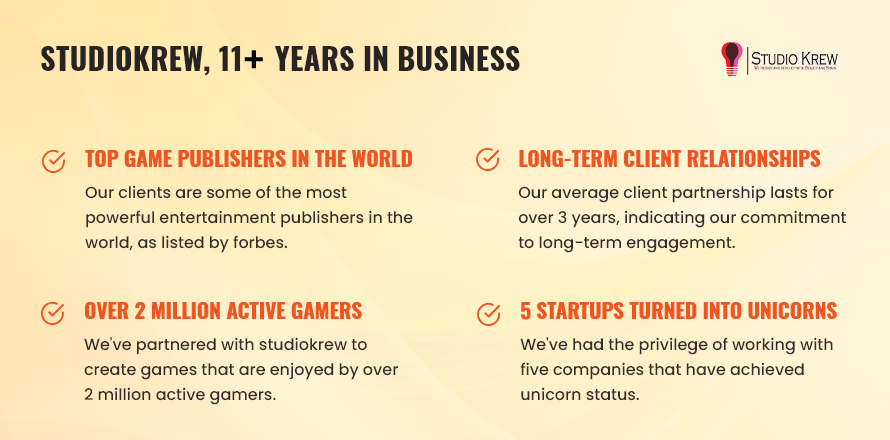
At StudioKrew, we understand the complexities of mobile game development and strive to deliver results that exceed expectations. Our experienced developers, designers, and strategists work tirelessly to bring your vision to life, leveraging the latest technologies and best practices to create immersive and engaging gaming experiences.
One key advantage of partnering with StudioKrew is our comprehensive approach to game development. We offer end-to-end solutions tailored to your needs and goals, from concept ideation and design to development, testing, and post-launch support.
Moreover, StudioKrew strongly emphasizes innovation and creativity. We constantly push the boundaries of what’s possible, exploring new ideas and technologies to stay ahead of the curve. When you choose StudioKrew, you’re not just getting a development team you’re— getting a partner dedicated to driving success and growth in the competitive world of mobile gaming.
In conclusion, entrusting your mobile game project to StudioKrew is a decision that makes sense on multiple fronts. With our proven track record, global presence, comprehensive services, and commitment to innovation, we’re well-positioned to bring your mobile game vision to life and help you succeed in the ever-evolving gaming world.

